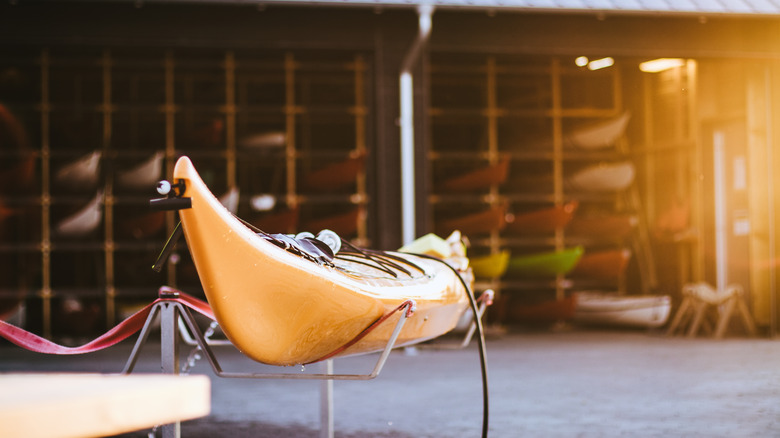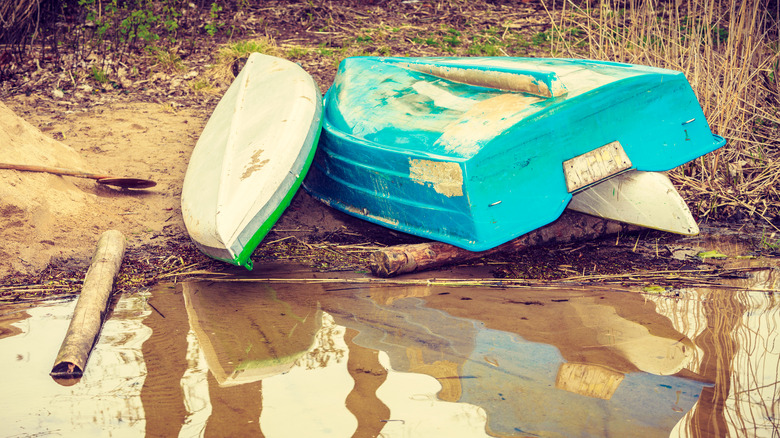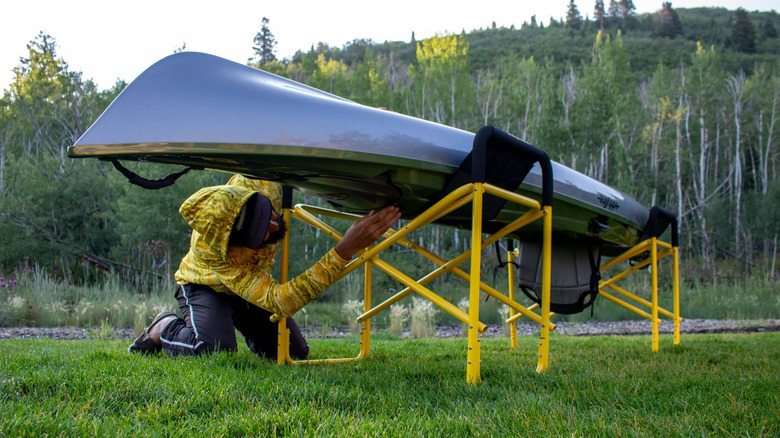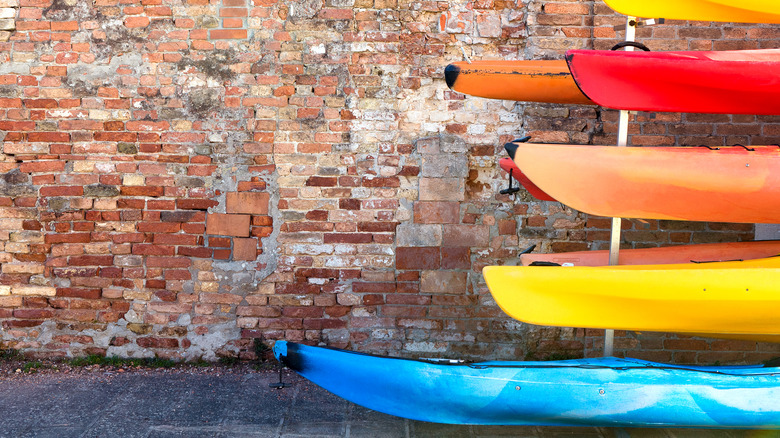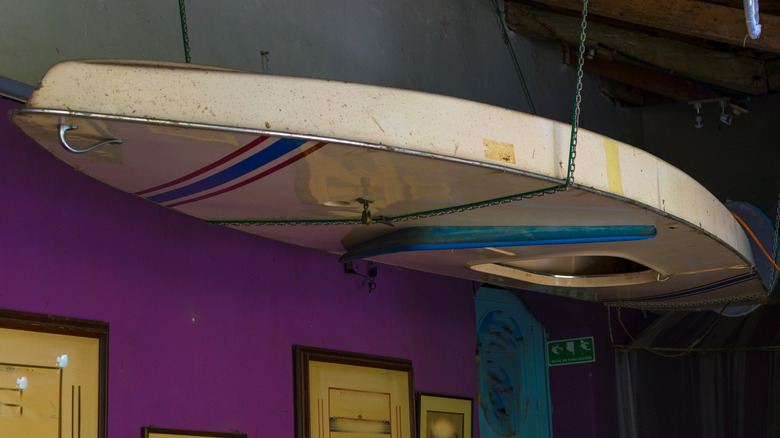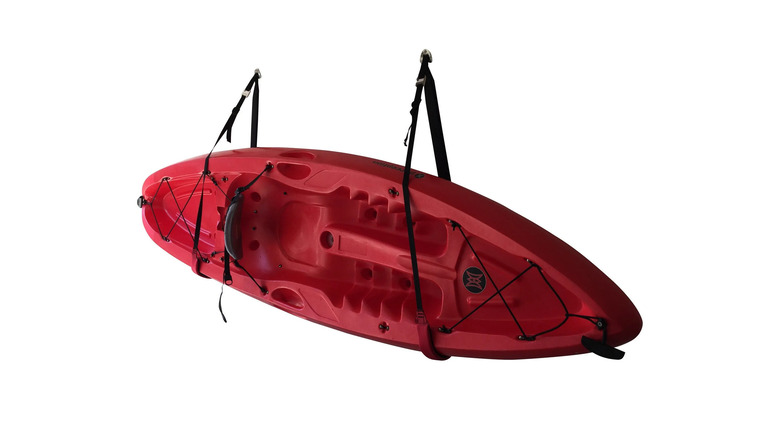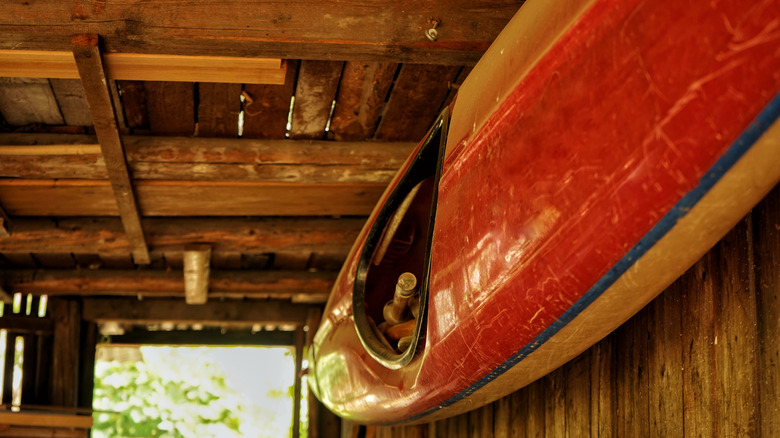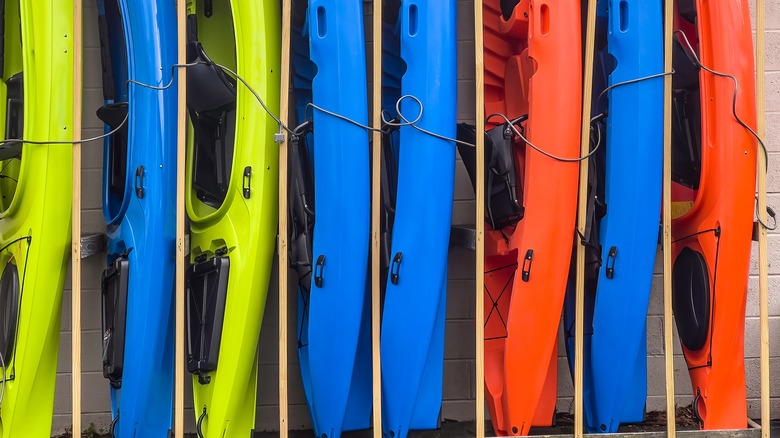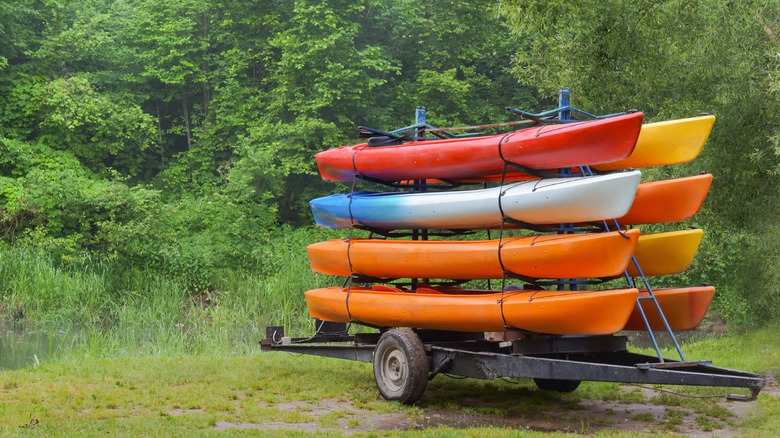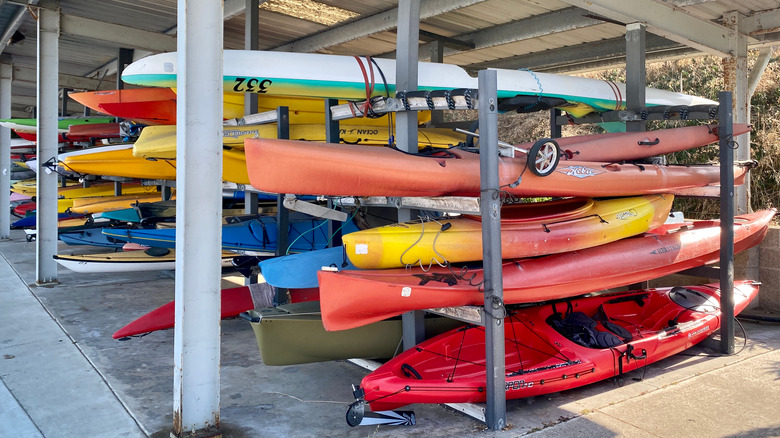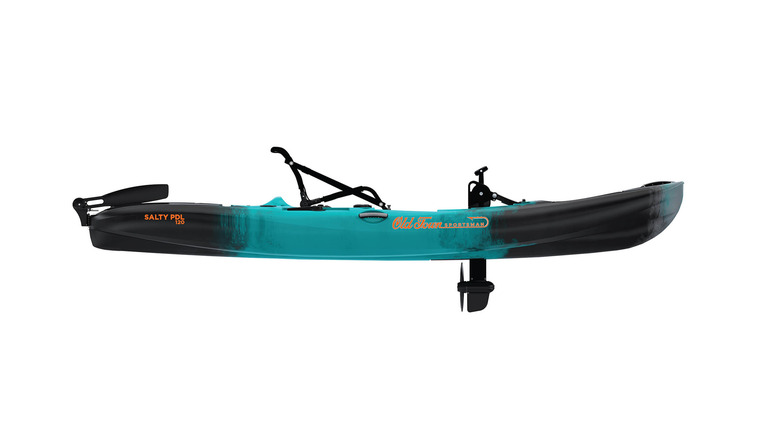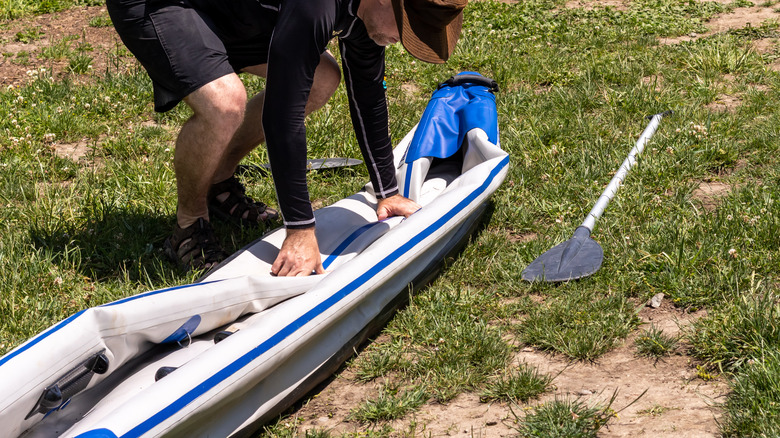Clever Ways To Store A Kayak Without Taking Over Your Garage
The notion of an ideal garage is relative. For you, an organized garage might be a Garage Living-style pathologically tidy, coated concrete showroom where you store tools you never use and sports equipment you only ever handled when hanging it on $7,000 worth of slatwall. Or, maybe, you'd just like to get your garage to the point that your passengers can walk around to the other side of the car rather than sliding over the hood like a '70s TV detective. Either way, dumping a couple of kayaks in the center of your garage isn't going to help anything. What you need is a clever storage solution. Or, hey, even a dimwitted storage solution, for that matter. Whatever works.
First, you have some things to think about. How many kayaks are we talking about here? Do you even have the option to store them indoors, or must you make do with dry docking al fresco? Also, what's the big deal? Doesn't plastic last a jillion years? Why not just lean it against the garage at a jaunty angle so the neighbors can see how casual you are about your healthy outdoors lifestyle? Well, their kids might steal it, for one thing. But aside from theft, you also have to protect kayaks from sun, heat, gravity, and moisture. In fact, from physics in general. When not touring the Intracoastal Waterway, kayaks should occupy the metaphysical plane. Let's take a look at what getting to kayak nirvana involves.
How to store a kayak
Polyethylene kayaks (which is most of them) can suffer from serious ultraviolet damage if stored in direct sunlight, according to Everything Kayak & Bicycles. Even fiberglass kayaks can eventually degrade in the sun. Most recommend storage indoors and, failing that, a fitted kayak cover or a loosely draped tarp that will allow airflow.
Improperly supporting your stored kayak can lead to warping. This is made worse by heat and cycles of freezing, which can also make polyethylene brittle. However tempting it is to store kayaks by the ends, the usual recommendation is to support the bow and stern about ⅓ of the way from each end to avoid sagging (via Old Town). You should also store your kayak deck-side-down (that is, upside-down), though it's okay to store a sit-on-top kayak on its side or deck-side-up if it's properly supported, which includes padding between the kayak and supports. Moisture will deteriorate the kayak's materials eventually, as well as causing mold. Open the drain plug and close all the hatches securely. Make sure it's dry, and that it stays that way.
As for theft, use common sense if you're not up to a full-blown "theft deterrence strategy" as outlined by PaddleGeek. At home, hide your kayak from plain view, at whatever cost this has to your outdoorsy cred with neighbors and the Instagram followers you imagine are poring over the backgrounds of your yoga photos. Use a good cable lock attached securely to both the kayak and its rack, a tree, etc. (via GILI Sports). If you really want to undermine all your image-building efforts, you can always give your kayak a faux finish that makes it look less like something worth stealing, though that feels a little over the top (via Kayak Help).
Sawhorses of all breeds
Sawhorses are the second most common place to store kayaks, after "over there by that bush." In fact, it's the reason lots of people own sawhorses in the first place. In this context, "sawhorse" is more of a class of solutions than literal sawhorse. The point is just to keep your kayak off the ground without warping it.
While stand up paddle boards are designed so that having purpose-built stands, like these from Suspenz, makes some sense, kayaks can really make do with a couple of slings of some sort (in fact, a lot of storage solutions rely on this basic method). You can buy expensive stands, like these glorified camping stools, but you can probably get away with a couple of cheap camp stools like these, just make sure they're wide enough. If you're more of a DIY type (or have more of a DIY budget), here's two big secrets for you. First, you can store a kayak on just about anything flat that's the right size to support it properly, so long as you have some padding (which can be accomplished with pool noodles, plumbing pipe insulation, etc.).
Kayak racks for every possible situation
If you have a lot of kayaks to contend with, what you might need is a high-capacity rack — and possibly some credit counseling. These are the sorts of things usually seen at kayaking clubs and summer camps, and they're indispensable for those with a whole herd of kayaks. Even if you only have a few, a big rack might make sense if you have also found yourself collecting canoes. Fortunately, you can build your own fairly easily and inexpensively using some of the plans shown by Kayak Help.
Since the high-capacity overkill rack is often just an excuse to buy more kayaks, you might be better-suited to a free-standing floor rack. This is another large class of options, from ridiculously expensive versions like the $1,239 Trailex aluminum rack (via Paddling Buyer's Guide) to cheap homemade versions. And then back to fairly expensive DIY versions like the Paddling Magazine DIY canoe tree. As tempting as a DIY is, you can probably do as well buying one online. At Amazon, you can easily purchase a two-boat (or even a four-boat) rack for less than $150. Remember that lumber and PVC aren't as cheap as they used to be.
You might have noticed that the Paddling Magazine canoe tree is firmly rooted to the ground, so keep that in mind when selecting a plan. If portability is something you desire, check out the kayak racks that roll — the ultimate in freestanding. This might be important, because racks take up a surprising amount of space, even though you're presumably stacking multiple boats in them.
Ceiling hoists and racks
So far, we've looked at self-contained storage solutions, and now we turn to ideas that rely on some kind of existing structure. Perhaps the most familiar of these is the canoe/kayak hoist, a system by which you can lift and hang your kayak (if you ever get the ropes untangled). Hoists are typically used in a garage or maybe a carport, says JD Hayes, but they can also serve in certain outdoor spaces, like underneath a second-story deck. If you have enough height and access available to you, you can even drive right under these hoists and load your kayak onto your car's roof rack. The DIY version is a couple of simple pulleys, or more. The genius of the dedicated kayak hoist is that it can be operated with one rope, and therefore comfortably by one person.
Models are available to hold around 200 pounds, such as the $117 Harken Hoister (via Paddling Magazine). And with 100-pound models available from Amazon for as little as $25, it might be hard to justify a DIY solution. Though, Nick over at Kayak Angler made a brilliantly simple one with a couple of D-rings and cam straps, and you're probably not going to get cheaper, more clever, or easier than that.
Of course, ceiling storage solutions don't have to be easy to use, and if you have no patience with such weakness, you can opt for overhead storage with a ceiling rack, which stores your kayak out of reach. These devices, often L-shaped or like inverted Ts, will certainly hold your kayak. What's less certain is how you get it up there to begin with. StoreYourBoard recommends a ladder, but lawyers don't.
Other under-deck solutions
Of course, anything you can do with a ceiling you can also do with the underside of a deck (well, relatively speaking). So, consider putting your ceiling rack under a deck with enough room below it. You can secure your kayak to the underside of a deck with straps made particularly for this purpose, or with simple ratcheting or cam straps you have lying around. However you choose to approach this project, just watch the metal buckles, hooks, etc., which can deal a lot of damage to a polyethylene hull. Also remember that under your deck is basically outside, so watch the weather extremes and sun exposure. That is sunlight getting between those deck boards, after all. You can even use straps that suspend your kayak on its side under decks, like the Tie Boss Kayak Hanger, though you should use a fitted cover or otherwise take care to keep water out.
Wall hanging straps and cradles
While we're on the topic of sideways straps — if straps can work on a ceiling, why not a wall? It turns out they do work, and rather well, assuming you have the wall space somewhere. There are even straps that let you hang two or more kayaks against a wall, like the $25 Cajun Tie Downs on Amazon. Like so many of these solutions, this can be a bit tricky to do solo, and made no less tricky by the floppiness of webbing straps.
Wall cradles, a marketing term for stuff you screw to the wall for hanging kayaks, do the same job without the floppiness. This could be a $751 number from Trailex (come on, folks, let go of that extra dollar!) that holds four kayaks, or an up-cycled lumber rack that holds three kayaks for $32.99 (via Amazon). Yes, that means that you can use them to store 68 kayaks for the same $751, but, of course, you're gonna need a bigger wall. Then there are simpler hooks that do basically the same job, and maybe more securely (via GILI Sports).
Bad solution: a vertical rack
Assuming you have the ceiling height to do so, you always have the space-saving option of storing your kayak vertically in a rack, though it's not the best idea. The unfortunate reality is that your kayak will deform very quickly, unless you take a great deal of care when storing it. Many use racks like this commercial number from Global Industrial. They can be quite expensive, so DIY solutions are fairly common, too.
There are some steps you can take to mitigate the possible damage from vertical storage. According to Storage Rentals of America, you can store the kayak on its stern, as long as it's on a cushion of some sort. Support the weight by attaching it to the wall with straps, or lean the kayak at an angle that you somehow know intuitively will help to distribute the weight less destructively (via Hull & Keel). The final step is to start saving money for a new kayak, because after a year or two, you'll likely notice your kayak doesn't hold up like it used to.
Marginal solution: trailers
For advertising your outdoorsy healthiness to more people than just your neighbors, you can't beat a kayak trailer. For a mere $1,700, you can own one and store six kayaks on it (via Paddling Buyer's Guide). But you might not be saving any space once you account for the length of the tongue (that part at the front) and the rest of the frame, the wheels, and the extra space you have to allow to pull a vehicle up to the trailer and maneuver it out of its parking space.
According to Paddling Magazine's Guide to Kayak Trailers, they are built with longer-than-usual tongues with suspension for lighter-than-usual loads. Of course, these features are useful if you're transporting kayaks and canoes, but you can store them on the trailer as well, since it's basically a freestanding kayak rack on road-legal wheels. It might be difficult to keep the sun and water away as effectively as you should, and be sure that the points of contact are properly padded. They are not, by default, on most trailers.
Non-solution solution: storing kayaks off-site
Not paying for things is possessed of a tedium all its own, possibly worse than the tedium of kayaking when you'd rather be watching golf on TV. If this describes you, consider paying a storage facility, a local park, or a kayak club to store your watercraft for you. Once it's locked away at whatever the name of that place was, you'll never have to think about it again.
You have three basic options for off-site storage: storage units, park facilities, and kayak clubs. These can be very basic, or can include such amenities as parking spaces, showers, and more, as you will find at New York's Touring Kayak Club. Some, like Steel City Rowing in Verona, PA, offer both indoor and outdoor storage. Perhaps the most affordable and easy-to-find storage is in state and municipal parks where paddling is popular. A year of storage at a park typically costs $100-200.
Life-saving solutions: pedal-drive kayaks
If you yearn for the days of youth spent trying to capsize rented swan-shaped paddle boats, too bad. You should have known the insurance companies would never let that happen. What you can capsize is a pedal-drive kayak. But can you store one? If you want to stay alive, maybe you have to.
Old Town has some advice if you plan to store a pedal-powered kayak. Store it inside, if possible; this is even more imperative than usual because the drivetrain components are susceptible to corrosion in weather. As always, use supports with plenty of surface area and padding. It's actually best to leave the drive mechanism in the kayak while storing; it provides additional support. And use storage as an opportunity for inspection and preventive maintenance. Pedal-drive craft have more moving parts than the usual kayak, and those can become loose, worn, dirty, and generally unruly by the end fo a kayaking season. Better not to store it that way and spoil next year's first day out.
Life-saving solutions II: the inflatable kayak
You bought an inflatable kayak because you have no interest in kayaking in the first place, and thought maybe the best way to avoid drowning is to use a floatation device as a boat. (Genius! Why doesn't everyone do this?) But now you've given up entirely, and it's time to learn how to store an inflatable kayak. Victoria Adams at Portable Kayaks outlines the fairly simple process. Inflate the kayak and clean it thoroughly, being sure to remove any mold. Deflate it as thoroughly as you can to make it as small as possible for storage, then put it away in its storage bag or another container, with some desiccant if you feel it's necessary.
Hide-Away Storage argues that you should store your kayak inflated, though many of the reasons don't seem to make sense — at least at first glance. Fortunately, they immediately reverse course and recommend storing it deflated, which makes it clear that Hide-Away Storage is running for public office. (Camillus Kayak Shop makes the same two arguments, for what it's worth, but Inflatable Kayak World says to definitely not store it inflated.) They also recommend applying a spray UV protectant and don't immediately recommend not using one, so maybe that's a safe bet.
Whatever you end up choosing, remember this: the best place to store your kayak, whenever you possibly can, is on the water. Say, around sunset. As far as possible from Amazon, social media, and DIY projects.
